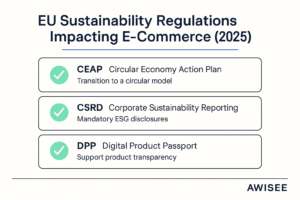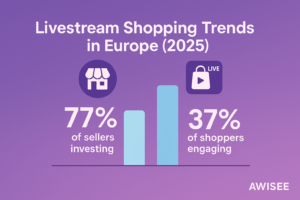It’s no secret that e-commerce in Europe is surging. From Berlin to Barcelona, online shopping is reshaping how Europeans engage with products, brands, and technology.
E-commerce in Europe 2025 marks a crucial shift in how the industry operates — from logistics and personalization to consumer expectations and regulatory frameworks.
In this article, we explore the six dominant forces shaping the landscape in 2025 — highlighting the European e-commerce market trends, consumer behavior, technology adoption, and what brands must prepare for next.
European E-commerce Market Trends in 2025
If you still think of online commerce as an “alternative” retail channel in Europe, it’s time to catch up.
Statista projects that total revenue in the European eCommerce market will hit US$529.8 billion in 2024. That number is expected to balloon to US$811.8 billion by 2029, growing at a CAGR of 8.91%.

That’s not a trend — that’s a digital retail revolution.
And it gets more compelling.
Forrester predicts that the Europe-5 — France, Germany, Italy, Spain, and the UK — will collectively grow their e-commerce sales from €389 billion in 2024 to €565 billion by 2029.
That’s 7.8% annual growth — with e-commerce set to claim 21% of retail in these five countries by 2029.
This remarkable surge is driven by:
- The adoption of omnichannel strategies
- Expanding cross-border marketplaces
- A shift in buyer preferences
- And greater price transparency
Cross-Border Expansion E-Commerce In Europe 2025
Cross-border sales are no longer fringe behavior — they’re central to e-commerce growth in European countries.
According to the 2024 European eCommerce Report,
International orders now make up 30% of total online sales in some regions

Consumers in Northern and Western Europe are at the forefront, spurred by smaller domestic markets and geographic proximity to neighboring nations.
But they’re also demanding.
European shoppers want:
- Fast, affordable delivery
- Clear customs policies
- Hassle-free return systems
To compete, brands need to:
- Localize checkout and shipping options
- Invest in e-commerce fulfillment in Europe by partnering with regional logistics providers for smoother last-mile delivery.
- Communicate return policies up front
In short, transparency and localization are the keys to winning the borderless buyer.
Online Shopping Behavior in Europe: European Online Consumer Behavior Analysis
Let’s look at how behaviors have shifted — and dramatically so.
In 2014, only 59% of EU internet users bought online. By 2024, that number hit 77%. Countries like Ireland (96%), the Netherlands (94%), and Denmark (91%) are virtually fully digital.

Others — like Italy, Bulgaria, and Romania — are catching up, hovering around 60%, and rising fast.
This wide adoption has created a mature, confident consumer base that values:
- Security
- Seamless UX
- Mobile-first performance
These evolving patterns are central to any serious European online consumer behavior analysis.
Payment Preferences & Checkout Expectations
European consumers are clear about what they want — speed, flexibility, and security.
In 2024, digital wallets accounted for one-third of all e-commerce transactions in Europe. Forecasts suggest this will hit 46% by 2030. That’s a huge leap from 2014.

Additionally, BNPL in Europe — led by platforms like Klarna and PayPal — is becoming essential, especially for younger shoppers managing inflation.
To keep carts from being abandoned, brands should:
- Offer multiple payment options (including local favorites)
- Promote secure encryption and fraud protection
- Make mobile checkout lightning-fast
Trust at checkout = conversions.
Technology Adoption Shaping E-commerce Experiences
Technology is now the backbone of Europe’s digital retail experience.
AI, AR, and VR in European Retail

Artificial Intelligence is revolutionizing how brands manage personalization, pricing, and support — all while staying compliant with regulations like GDPR and the upcoming EU AI Act.
Meanwhile, AR and VR are becoming standard in industries like fashion and home decor:
- Virtual try-ons
- Room visualizers
- Immersive product demos
The payoff? Higher buyer confidence and fewer returns.
Real-Time Analytics & Predictive Tools
Data today drives momentum — not just measurement.
European retailers are deploying predictive tools to make inventory, logistics, and marketing smarter and faster. Whether it’s real-time demand forecasting or dynamic price adjustments, the name of the game is responsiveness.
Brands using analytics to fine-tune their decision-making will have the upper hand, especially in such a fast-evolving market.
Sustainability & Regulation: The New Imperatives
Sustainability has officially shifted from “nice to have” to “must-have.” In e-commerce in Europe 2025, how your product arrives matters just as much as what you’re selling.
Under the EU’s Circular Economy Action Plan (CEAP), brands must reduce packaging waste and show measurable improvements. And with the Corporate Sustainability Reporting Directive (CSRD) taking full effect in 2025, transparency is no longer optional — it’s mandatory.

The upcoming Digital Product Passport (DPP), set to roll out in 2027, will require detailed reporting on environmental impact, from sourcing to disposal.
Here’s what brands need to do:
- Adopt eco-friendly packaging — recyclable, reusable, or compostable.
- Improve product information to reduce return rates.
- Publicly showcase your sustainability efforts — eco-conscious shoppers in Europe increasingly base purchasing decisions on a brand’s green transparency.
These green strategies will be essential across all European e-commerce market trends.
E-commerce Compliance in the EU
The regulatory environment in Europe has reached a new level of complexity, and it’s shaping how brands operate online.
The Digital Services Act (DSA) and Digital Markets Act (DMA) demand:
- Greater ad transparency
- Clearer content moderation
- In simpler terms of service
Pair that with GDPR enforcement and the upcoming EU AI Act, and it’s clear: e-commerce growth in European countries is directly linked to legal adaptation.
VAT is no easier. While OSS and IOSS simplify tax collection for cross-border trade, missteps can be costly.
To Stay Compliant, Brands Should:
- Work with legal experts in European digital commerce
- Audit AI use cases and update customer-facing tech
- Use OSS tools for streamlined reporting and tax accuracy
Make Sustainability Sell with Smart SEO
With sustainability rising as a decisive factor for European buyers, your green efforts should rank just as high as your products. AWISEE helps e-commerce brands turn sustainability into a growth driver through targeted e-commerce SEO in Europe and platform-specific ad strategies.
AWISEE helps you build visibility, engagement, and conversions via SEO and platform-specific ad strategies designed for livestream performance.
Build visibility, trust, and conversions — sustainably.
Schedule your consultation with AWISEE.
The Livestream Commerce Surge in Europe
McKinsey predicts that 20% of global e-commerce sales could come from live shopping by 2026. Europe is charging ahead, not trailing behind.
As of 2025:
- 37% of European consumers shop via livestream more often

- 94% of live sellers say it’s critical to their business
- 78% are expanding their live commerce investments
This isn’t a passing trend. In fact, it’s one of the major e-commerce trends in Europe for 2025.
What’s Driving This Boom?
Platforms like Whatnot are enabling a new breed of commerce.
Key stats:
- 70% of UK sellers now earn most of their income via livestreams
- Shoppers view 20,000+ hours of live streams weekly
- Fashion livestreaming in the UK is growing by 90% every quarter
This is more than sales — it’s storytelling. Community-driven shopping experiences are redefining digital engagement.
Regional Breakdown: E-commerce Growth in European Countries

Western Europe continues to dominate the retail landscape.
- Germany: €693 billion projected in retail sales by 2029
- France: €616 billion
- UK: €649 billion (converted)
Amazon is ahead, but smart localization, personalization, and logistics can help newcomers carve out space.
Southern Europe: Mobile-First Momentum
Italy, Spain, and Portugal are leading the mobile surge, making them central to the rise of m-commerce in Europe.
Rapid smartphone adoption and growing trust in apps are changing the dynamics. Success here depends on seamless, mobile-optimized shopping and flexible digital payment integrations.
Eastern Europe: Emerging But Promising
With a 15% B2C e-commerce turnover increase in 2023, Eastern Europe is gaining serious momentum.
Markets like Poland and Romania are on the rise. Infrastructure challenges exist, but flexible payment systems and local delivery partners are the key to unlocking potential.
Online shopping habits vary widely across Europe — brands must tailor strategies by region.
Future Projections for E-commerce in Europe
By 2029:
- Europe will have 485.6 million online shoppers
- User penetration will rise from 51.1% to 60.8%
- Online sales will reach $811.8 billion
Forrester also predicts a 7.8% CAGR, while offline retail will crawl at just 1.7%.
These future projections for e-commerce in Europe show where the real momentum lies: digital, personalized, and omnichannel.
If your company is exploring digital PR for e-commerce or needs online reputation management, take a look at these top digital PR agencies in Europe.
Online Shopper Penetration in Europe (2024–2029)
Description: The line graph shows the rise in online shopping penetration across the continent, from 51.1% in 2024 to 60.8% by 2029.
Key Strategic Recommendations for Brands

What’s next? Action.
- Prioritize mobile-first experiences, especially in Southern Europe
- Invest in livestream strategies to build engagement
- Stay compliant with AI and VAT frameworks
- Embrace transparency and sustainability in marketing
- Localize payments, shipping, and returns
For those wondering, what is the future outlook for e-commerce in Europe? It’s community-driven, compliance-ready, and mobile-dominant.
E-commerce in Europe 2025 isn’t just evolving — it’s being reinvented from the ground up.




